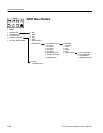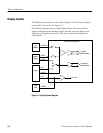
Theory of Operation
2715 Spectrum Analyzer Service Manual
3-5
The Display Storage board is capable of storing four waveforms of 512 bytes
each, four pages of text of 512 bytes each, and up to two markers. Any combina-
tion of waveforms and text may be displayed on the CRT. If any waveforms are
being displayed, the text portion of the display is limited to approximately 100
characters in order to avoid flicker.
Only one page of text may be displayed at any one time. The readout page is
limited to approximately 100 characters.
The waveforms and text displays are accessed through memory reads and writes.
When (DISPLAY) A, B, C, or D is selected, the stored waveforms in those
registers are displayed. When A, B, C, and D are deselected, the display reverts
to the real time (nondigitized) video waveform, and the readout is updated during
the readout cycle.
Center Frequency Control
The Center Frequency Control system provides 1st Local Oscillator (1st LO)
signal to the 1st Converter at the center frequency and span selected by the user.
In general, this is accomplished by a combination of setting, counting, and
resetting (as required) of the frequencies of various oscillators.
The system is expected to control the frequency within a few Hz out of a total
operating range of approximately 2 GHz.
The principal elements of the frequency control system are as follows:
This is a YIG tuned oscillator that covers the range of 2.11 to 3.91 GHz or 2.11
to 4.26 GHz for Option 50 and Option 75 (YIG = Yttrium Iron Garnet.) Ideally,
its operating frequency is exactly proportional to the strength of an internal DC
magnetic field. This field is the combined field of two coils, one large (Main)
and one small (FM). In practice, the frequency is uncertain by up to a few MHz
due to problems such as temperature drift, slight nonlinearity, and magnetic
hysteresis. Also, the oscillator has some residual FM and phase noise sidebands
due to internal causes and external noise and drift from the driver circuit. The
remainder of the frequency control system maintains the oscillator (abbreviated
YIG) at the right frequency. Usually, it is sufficient to set the YIG, then
periodically check its frequency and make small adjustments as required.
However, in very narrow spans the YIG must be phase locked to a stable source
in order to maintain sufficient stability.
The 1st LO Interface provides drive signals for the main coil and FM coil, a
control signal for the main coil, and power for the gain stage.
1
st
LO


















